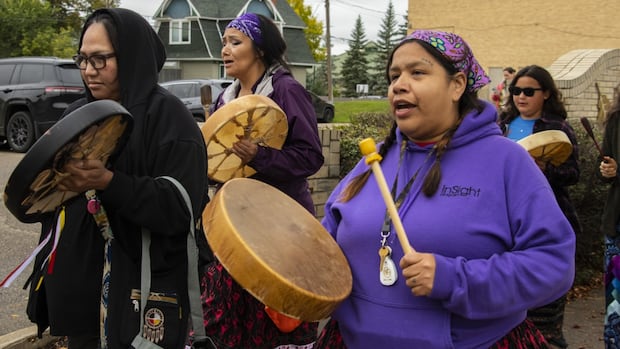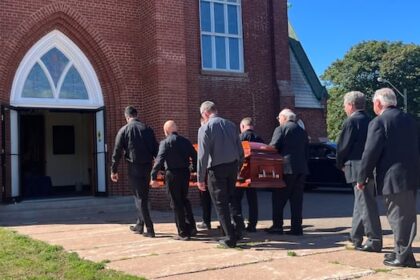ManitobaSexual exploitation and human trafficking are happening across Canada — including in Brandon, say the organizers of an annual walk to raise awareness of the issue in southwestern Manitoba.Brandon’s annual Grandmothers Walk calls for action on traffickingChelsea Kemp · CBC News · Posted: Sep 20, 2025 7:00 AM EDT | Last Updated: 3 hours agoWestman’s Sexual Exploitation Awareness Team was joined by more than 100 people at Brandon’s Princess Park Friday for the annual Grandmothers Walk Protecting Sacred Lives, a march against sexual exploitation and trafficking. (Chelsea Kemp/CBC)Sexual exploitation and human trafficking are happening across Canada — including in Brandon, say the organizers of an annual walk to raise awareness of the issue in southwestern Manitoba.The event, called the Grandmothers Walk Protecting Sacred Lives, is organized by the Westman Sexual Exploitation Awareness Team committee, and offers an important chance to talk publicly about the issue, says committee member Lisa Noctor.”It’s just important for community to recognize what’s happening, to see what’s happening, to talk out loud about what’s happening and to look for solutions,” Noctor said.This year’s march was held Friday at Princess Park. The walk was launched in 2007 by Elder Margaret Lavallee, who was horrified by the story of a 12-year-old girl who was impregnated by her grandfather, and then cast out of her community. Noctor says exploitation and trafficking has become more visible in the Westman region, but what worries her most are the cases that remain hidden.The sex trade victimizes hundreds of children, youth and adults across Manitoba every year, the province says. Most adult sex trade workers say their victimization began at a very young age — sometimes as young as nine, and on average at the age of 14, according to the province.Despite support from dedicated teams and families, there are still gaps that leave people vulnerable, particularly those with cognitive and intellectual disabilities, said Noctor.”Our rural areas absolutely have an exploitation and trafficking problem,” she said. “But our rural areas are some of our most polite areas, where it’s easiest to look away.”Exploitation in farming communities is a concern, with young people often transported between communities and exploited along the way, said Noctor.”If you’ve got an older gentleman from a farming community all of a sudden driving around with an Indigenous girl who’s not from that community, we should be asking why,” she said.While reporting can be difficult — or dangerous, in some cases — it is necessary, said Noctor.”If we see something, say something. That’s the only way that we’re going to be able to move forward.”Walking with youthOver the years, the Grandmothers Walk has become intergenerational, with youth bringing new energy to the cause, said Noctor.Among them was 18-year-old Ayanna Spence, who attended Friday’s walk with her mom. After partying and using substances when she was younger, she now looks up to the drummers and singers who took part in the walk, said Spence.”It feels really good to be included in stuff like this,” she said. “I’m going to come back next year.”Youth involvement is key, organizers say.”This year we saw a lot of new faces, especially in some of our younger generation,” said Samantha van den Ham, chair of the Westman Sexual Exploitation Awareness Team committee.”It was really nice to have them during the walk, sing the songs and bring a lot of heart to our march this year.”Van den Ham said the team’s goal is to protect children from exploitation, whether that’s sexting, online coercion or other risks.”We want them to learn that sexual exploitation happens in any location. It doesn’t matter what your background is,” she said.The committee’s role is to raise awareness, provide education and resources, and most importantly remind people they are not alone, van den Ham said.The biggest change in helping the community has been collaboration — bringing organizations together so people can access resources like GAP Youth Outreach or Youth for Christ, she said.Among the people who joined this year’s walk were Brandon Mayor Jeff Fawcett, police Chief Tyler Bates and representatives from Child and Family Services of Western Manitoba. Noctor said their presence is critical, as systemic change requires leadership — and more work is still needed to ensure people facing exploitation have real options.The Sexual Exploitation Awareness Team says sexual exploitation and trafficking is on the rise in the Westman region. (Chelsea Kemp/CBC)She highlighted the Brandon Police Service’s counter-exploitation position — which hasn’t been staffed for months — as an example.Brandon police told CBC in an email the role is set to restart in October.Noctor, who is also the GAP Youth Outreach outreach co-ordinator, said while the challenges remain, seeing youth at the walk gives her hope.Many survivors have valuable skills that go unrecognized, from business smarts to crisis de-escalation. Communities need to create space for those strengths to grow, she said.”Understand that those are still people that you’re seeing, and see them first,” said Noctor. “See kindness. See their strengths. See their gifts.”ABOUT THE AUTHORChelsea Kemp is a multimedia journalist with CBC Manitoba. She is based in CBC’s bureau in Brandon, covering stories focused on rural Manitoba. Share your story ideas, tips and feedback with chelsea.kemp@cbc.ca.
Monday, 22 Dec 2025
Canada – The Illusion
Search
Have an existing account?
Sign In
© 2022 Foxiz News Network. Ruby Design Company. All Rights Reserved.
You May also Like
- More News:
- history
- Standing Bear Network
- John Gonzalez
- ᐊᔭᐦᑊ ayahp — It happened
- Creation
- Beneath the Water
- Olympic gold medal
- Jim Thorpe
- type O blood
- the bringer of life
- Raven
- Wás’agi
- NoiseCat
- 'Sugarcane'
- The rivers still sing
- ᑲᓂᐸᐏᐟ ᒪᐢᑿ
- ᐅᑳᐤ okâw — We remember
- ᐊᓂᓈᐯᐃᐧᐣ aninâpêwin — Truth
- This is what it means to be human.
- Nokoma











